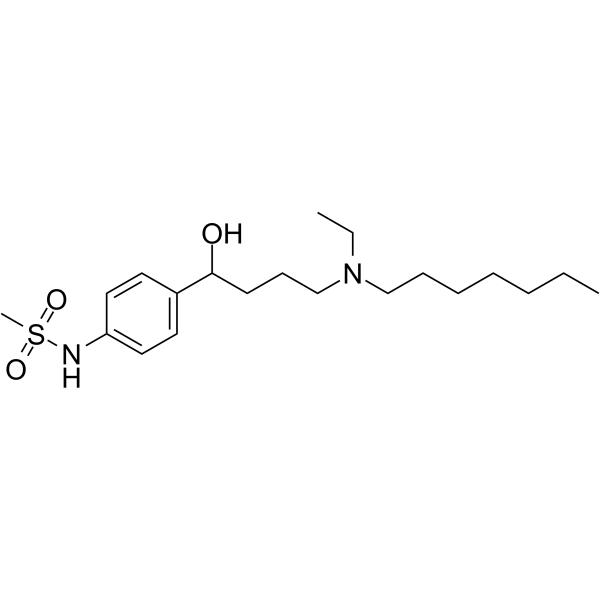| Description |
Ibutilide (U70226E free base), an action potential-prolonging antiarrhythmic, is a potent blocker of the rapidly activating delayed rectifier K+ current (IKr) in AT-1 cells[1].
|
| Related Catalog |
|
| In Vitro |
Ibutilide is a potent IKr blocker with EC50 value of 20 nM at +20 mV in atrial tumor myocytes (AT-1) cells[1]. Ibutilide blocks IKr in cells expressing HERG+MDR1*1 to the same extent as cells expressing HERG alone (IC50: 22.5±0.9 vs 27.4±2.5 nM). However, cells expressing MDR1*7 show a marked resistance to Ibutilide (IC50: 105.3±1.42 nM vs 27.4±2.5 nM)[2].
|
| In Vivo |
Ibutilide prolongs cardiac repolarization in vitro and in vivo[1]. Ibutilide infusions (administered cumulatively in three doses, 0.01, 0.02 and 0.05 mg/kg i.v., each as a 10-min infusion) results in both polymorphic and monomorphic non-sustained ventricular tachycardia[3]. Animal Model: Fifteen adult mongrel dogs of either sex[1] Dosage: 0.01, 0.02 and 0.05 mg/kg Administration: Infusion Result: The action potential duration at 90% (APD90) prolongation with Ibutilide (0.01 mg/kg) was significantly greater in congestive heart failure (CHF) vs. controls. An increased dispersion of left–right ventricular APD90 was observed in CHF at 0.01 mg/kg, but not in controls.
|
| References |
[1]. Ibutilide, a methanesulfonanilide antiarrhythmic, is a potent blocker of the rapidly activating delayed rectifier K+ current (IKr) in AT-1 cells. Concentration-, time-, voltage-, and use-dependent effects. Circulation. 1995 Mar 15;91(6):1799-806. [2]. B F McBride, et al. Influence of the G2677T/C3435T haplotype of MDR1 on P-glycoprotein trafficking and Ibutilide-induced block of HERG. Pharmacogenomics J. 2009 Jun;9(3):194-201. [3]. S S Chugh, et al. Altered response to Ibutilide in a heart failure model. Cardiovasc Res. 2001 Jan;49(1):94-102.
|
